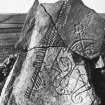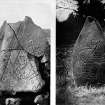Logie Elphinstone
Ogham Inscribed Stone (Pictish), Pictish Symbol Stone (Pictish)
Site Name Logie Elphinstone
Classification Ogham Inscribed Stone (Pictish), Pictish Symbol Stone (Pictish)
Alternative Name(s) Logie House Policies; Logie Elphinstone No. 2; Moor Of Carden
Canmore ID 18855
Site Number NJ72NW 7.02
NGR NJ 7034 2588
Datum OSGB36 - NGR
Permalink http://canmore.org.uk/site/18855
- Council Aberdeenshire
- Parish Chapel Of Garioch
- Former Region Grampian
- Former District Gordon
- Former County Aberdeenshire
Logie Elphinston 2, Aberdeenshire, Pictish symbol stone
Measurements: H 1.37m above ground, W & D 0.46m max
Stone type: whinstone
Place of discovery: NJ c 69 26
Present location: set upright in the grounds of Logie Elphinstone House, to the west of the house at NJ 7033 2588.
Evidence for discovery: this was one of four stones found lying on the ground on the Moor of Carden to the west of Logie Elphinstone House in or prior to about 1821. At that time the moor was planted and three of the stones were built into the enclosing wall, while the fourth (which is not known certainly to have been carved) was used as a floor slab in a kiln and ‘split by the heat and destroyed’. The three symbol stones were subsequently removed from the wall and erected in the house grounds.
Present condition: weathered.
Description
A pointed pillar-shaped stone was chosen for this symbol stone. Initially the stone was incised with a single symbol, a double disc and Z-rod set at a slight angle with the right-hand disc higher than that on the left. Each disc is composed of two concentric circles and the rod has a double outline. This symbol had become quite faint by the time that a pair of symbols was superimposed upon it: a crescent and V-rod above a double disc and Z-rod, set horizontally. This time the discs are plain and the rod id drawn with a single line. Above the symbols is an incised circle forming the base line for an ogham inscription, which reads QFTQU.
Date: seventh century.
References: Stuart 1856, 4; ECMS pt 3, 176-7; Forsyth 1996, 385-401; Clarke 2007; Fraser 2008, no 32.2.
Desk-based information compiled by A Ritchie 2017
NJ72NW 7.02 7034 2588.
No. 2. This stone measures 1.37m x 0.76m x 0.45m and tapers to a point towards the top. The stone bears an Ogam inscription arranged around a circular stem and below this the crescent and V-rod symbol. There are traces of a double-disc symbol which appears to have been erased to make way for a rod and larger double disc enclosed with the two ornamental bars of a Z-rod with no diagonal.
J Skene 1832; J Stuart 1856; G Moore 1865; J Rhys 1892; J R Allen and J Anderson 1903; W D Simpson 1943.
Antiquarian Observation (1893 - 1900)
Correspondence, sketches and photographs relating to the interpretation of the ogham inscription on the Logie Elphinstone Pictish symbol stone no.2, Aberdeenshire.
Reference (1963)
(Location cited as NJ 702 659). A Class I stone, one of three found near by on the Moor of Carden, aws taken to Logie Elphinstone. It bears two series of symbols on one face, one apparently erased in favour of the other. The erased symbol seems to have been part of a double disc and Z-rod, but parts of it still show, as the erasing was not completely effective. This is overlain in part by the crescent and V-rod and in part by another double disc and Z-rod symbol. Above all the symbols is a wheel Ogam, an incised circle to the circumference of which six or seven Ogam cipher characters are appended.
R W Feachem 1963.
Field Visit (5 September 2001)
The second of the symbol stones stands on the W of the group, and faces E. A granite boulder of pointed profile, it measures 1.34m in height, by 0.70m in breadth, by 0.33m in thickness. The head of the stone bears an incised ring-ogam. Below this is a crescent and V-rod symbol, and below this a double-disc and Z-rod symbol. The central portion of the crescent is decorated by two spirals, and its extremities by a simple shape reflecting the curve of the crescent and the transecting line of the V-rod. The head of the V-rod terminates in a leaf-shaped blade with two rear-ward curving lines at its base. Its tail terminates in a pelta-shape. The double-disc is undecorated, except for two curving lines which enrich the connecting bar. The head and tail of the Z-rod terminate respectively in three pairs and a single pair of forward-curving curlicues. Both of these symbols overlie an earlier double-disc and Z-rod symbol. Whereas the lines of the overlying symbols have been smoothed out, those of the underlying symbol are roughly pecked, and appear to indicate an earlier, uncompleted design. The discs are each simply decorated with a concentric circle. The lower arm of the Z-rod has been largely erased, but the upper arm retains traces of a curvilinear terminal.
Visited by RCAHMS (IFr), 5 September 2001.






















































